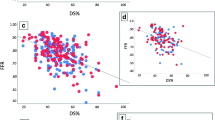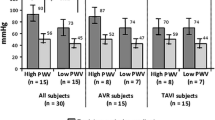Abstract
Aortic stenosis (AS) is the most common valvular disease and aortic valve replacement (AVR) is one of its most effective interventions. AS affects not only the left ventricle, but also vascular function beyond the stenotic valve, which can lead to various types of vascular dysfunction. However, research evaluating the effect of AS on aortic vascular function is limited. In this study, we investigated clinical meaning to evaluate endothelial function in subjects with AS. From April 2011 to April 2012, 20 consecutive adult patients with degenerative AS (mean age, 74.7 ± 7.4 years; range 50–83 years) who underwent AVR at our institution were included in the study. We measured flow-mediated dilation (FMD) to evaluate the effect of AS on endothelial function. The difference between brachial artery diameter (BAD) before (4.0 ± 0.7 mm) and after AVR (3.9 ± 0.6 mm) was not significant (p = 0.043), but FMD significantly improved after AVR (from 3.1 ± 1.8 to 6.0 ± 2.7 %, p < 0.0001). We also analyzed FMD × BAD index, endogenous vasodilatory capability independent of BAD, resulting that it also significantly increased after AVR (12.3 ± 7.0–22.5 ± 9.3, p < 0.0001). We divided patients into two groups by pre- to post-AVR change in FMD (ΔFMD); large-ΔFMD group [ΔFMD >3.0 % (median value)] and small-ΔFMD group (ΔFMD <3.0 %). There were no significant changes in age, blood pressure, heart rate, B-type natriuretic peptide, or echocardiographic parameters in either group. In contrast, BAD was significantly larger in the small ΔFMD group (4.3 ± 0.7 mm) than in the large ΔFMD group (3.7 ± 0.7 mm) (p = 0.030). In addition, cardio-thoracic ratio was significantly greater in the small ΔFMD group (58.4 ± 7.1 %) than in the large ΔFMD group (53.7 ± 4.6 %) (p = 0.048). Receiver operating characteristic curve analysis of BAD to differentiate large and small ΔFMD demonstrated an area under the curve of 0.750 (p = 0.059) and that optimal cutoff for BAD was 4.28 mm (70 % sensitivity, 80 % specificity). AVR in subjects with AS is associated with a significant improvement in FMD in the brachial artery. Measurement of the BAD may be helpful in distinguishing whether the impairment of FMD in AS derives from a stenotic valve or vascular remodeling.





Similar content being viewed by others
References
Blais C, Pibarot P, Dumesnil JG, Garcia D, Chen D, Durand LG (2001) Comparison of valve resistance with effective orifice area regarding flow dependence. Am J Cardiol 88:45–52
Bermejo J, Odreman R, Feijoo J, Moreno MM, Gomez-Moreno P, Garcia-Fernandez MA (2003) Clinical efficacy of Doppler-echocardiographic indices of aortic valve stenosis: a comparative test-based analysis of outcome. J Am Coll Cardiol 41:142–151
Bonow RO, Carabello B, De Leon AC Jr., Edmunds LH Jr., Fedderly BJ, Freed MD, Gaasch WH, Mckay CR, Nishimura RA, O’gara PT, O’rourke RA, Rahimtoola SH, Ritchie JL, Cheitlin MD, Eagle KA, Gardner TJ, Garson A Jr., Gibbons RJ, Russell RO, Ryan TJ, Smith SC Jr. (1998) Guidelines for the management of patients with valvular heart disease: executive summary. A report of the American College of Cardiology/American Heart Association Task Force on Practice Guidelines (Committee on Management of Patients with Valvular Heart Disease). Circulation 98:1949–1984
Briand M, Dumesnil JG, Kadem L, Tongue AG, Rieu R, Garcia D, Pibarot P (2005) Reduced systemic arterial compliance impacts significantly on left ventricular afterload and function in aortic stenosis: implications for diagnosis and treatment. J Am Coll Cardiol 46:291–298
Garcia D, Barenbrug PJ, Pibarot P, Dekker AL, Van Der Veen FH, Maessen JG, Dumesnil JG, Durand LG (2005) A ventricular-vascular coupling model in presence of aortic stenosis. Am J Physiol Heart Circ Physiol 288:H1874–H1884
Rieck AE, Cramariuc D, Boman K, Gohlke-Barwolf C, Staal EM, Lonnebakken MT, Rossebo AB, Gerdts E (2012) Hypertension in aortic stenosis: implications for left ventricular structure and cardiovascular events. Hypertension 60:90–97
Yamaura Y, Nishida T, Watanabe N, Akasaka T, Yoshida K (2004) Relation of aortic valve sclerosis to carotid artery intima-media thickening in healthy subjects. Am J Cardiol 94:837–839
Otto CM, Lind BK, Kitzman DW, Gersh BJ, Siscovick DS (1999) Association of aortic-valve sclerosis with cardiovascular mortality and morbidity in the elderly. N Engl J Med 341:142–147
Aronow WS, Ahn C, Shirani J, Kronzon I (1998) Comparison of frequency of new coronary events in older persons with mild, moderate, and severe valvular aortic stenosis with those without aortic stenosis. Am J Cardiol 81:647–649
Takata M, Amiya E, Watanabe M, Omori K, Imai Y, Fujita D, Nishimura H, Kato M, Morota T, Nawata K, Ozeki A, Watanabe A, Kawarasaki S, Hosoya Y, Nakao T, Maemura K, Nagai R, Hirata Y, Komuro I (2013) Impairment of flow-mediated dilation correlates with aortic dilation in patients with Marfan syndrome. Heart Vessels. doi:10.1007/s00380-013-0393-
Kodali SK, Moses JW (2012) Coronary artery disease and aortic stenosis in the transcatheter aortic valve replacement era: old questions, new paradigms: the evolving role of percutaneous coronary intervention in the treatment of patients with aortic stenosis. Circulation 125:975–977
Watanabe S, Amiya E, Watanabe M, Takata M, Ozeki A, Watanabe A, Kawarasaki S, Nakao T, Hosoya Y, Omori K, Maemura K, Komuro I, Nagai R (2013) Simultaneous heart rate variability monitoring enhances the predictive value of flow-mediated dilation in ischemic heart disease. Circ J 77:1018–1025
Mizia-Stec K, Gasior Z, Mizia M, Haberka M, Holecki M, Zwolińska W, Katarzyna K, Skowerski M (2007) Flow-mediated dilation and gender in patients with coronary artery disease: arterial size influences gender differences in flow-mediated dilation. Echocardiography 10:1051–1057
Freeman RV, Otto CM (2005) Spectrum of calcific aortic valve disease: pathogenesis, disease progression, and treatment strategies. Circulation 111:3316–3326
Otto CM, Kuusisto J, Reichenbach DD, Gown AM, O’brien KD (1994) Characterization of the early lesion of ‘degenerative’ valvular aortic stenosis. Circulation 90:844–853
Stewart BF, Siscovick D, Lind BK, Gardin JM, Gottdiener JS, Smith VE, Kitzman DW, Otto CM (1997) Clinical factors associated with calcific aortic valve disease. Cardiovascular Health Study. J Am Coll Cardiol 29:630–634
Gotoh T, Kuroda T, Yamasawa M, Nishinaga M, Mitsuhashi T, Seino Y, Nagoh N, Kayaba K, Yamada S, Matsuo H (1995) Correlation between lipoprotein (a) and aortic valve sclerosis assessed by echocardiography (the JMS Cardiac Echo and Cohort Study). Am J Cardiol 76:928–932
Rossi A, Faggiano P, Amado AE, Cicoira M, Bonapace S, Franceschini L, Dini FL, Ghio S, Agricola E, Temporelli PL, Vassanelli C (2013) Mitral and aortic valve sclerosis/calcification and carotid atherosclerosis: results from 1065 patients. Heart Vessels. doi:10.1007/s00380-013-0433-z
Chenevard R, Bechir M, Hurlimann D, Ruschitzka F, Turina J, Luscher TF, Noll G (2006) Persistent endothelial dysfunction in calcified aortic stenosis beyond valve replacement surgery. Heart 92:1862–1863
Poggianti E, Venneri L, Chubuchny V, Jambrik Z, Baroncini LA, Picano E (2003) Aortic valve sclerosis is associated with systemic endothelial dysfunction. J Am Coll Cardiol 41:136–141
Schumm J, Luetzkendorf S, Rademacher W, Franz M, Schmidt-Winter C, Kiehntopf M, Figulla HR, Brehm BR (2011) In patients with aortic stenosis increased flow-mediated dilation is independently associated with higher peak jet velocity and lower asymmetric dimethylarginine levels. Am Heart J 161:893–899
Rosca M, Magne J, Calin A, Popescu BA, Pierard LA, Lancellotti P (2011) Impact of aortic stiffness on left ventricular function and B-type natriuretic peptide release in severe aortic stenosis. Eur J Echocardiogr 12:850–856
Fang ZY, Marwick TH (2002) Vascular dysfunction and heart failure: epiphenomenon or etiologic agent? Am Heart J 143:383–390
Hildick-Smith DJ, Shapiro LM (2000) Coronary flow reserve improves after aortic valve replacement for aortic stenosis: an adenosine transthoracic echocardiography study. J Am Coll Cardiol 36:1889–1896
Chiu JJ, Chien S (2011) Effects of disturbed flow on vascular endothelium: pathophysiological basis and clinical perspectives. Physiol Rev 91:327–387
Cheng C, Tempel D, Van Haperen R, Van Der Baan A, Grosveld F, Daemen MJ, Krams R, De Crom R (2006) Atherosclerotic lesion size and vulnerability are determined by patterns of fluid shear stress. Circulation 113:2744–2753
Phinikaridou A, Hua N, Pham T, Hamilton JA (2013) Regions of low endothelial shear stress colocalize with positive vascular remodeling and atherosclerotic plaque disruption: an in vivo magnetic resonance imaging study. Circ Cardiovasc Imaging 6:302–310
Holubkov R, Karas RH, Pepine CJ, Rickens CR, Reichek N, Rogers WJ, Sharaf BL, Sopko G, Merz CN, Kelsey SF, Mcgorray SP, Reis SE (2002) Large brachial artery diameter is associated with angiographic coronary artery disease in women. Am Heart J 143:802–807
Dibble CT, Shimbo D, Barr RG, Bagiella E, Chahal H, Ventetuolo CE, Herrington DM, Lima JA, Bluemke DA, Kawut SM (2012) Brachial artery diameter and the right ventricle: the Multi-Ethnic Study of Atherosclerosis-right ventricle study. Chest 142:1399–1405
Fukuta H, Ohte N, Brucks S, Carr JJ, Little WC (2007) Contribution of right-sided heart enlargement to cardiomegaly on chest roentgenogram in diastolic and systolic heart failure. Am J Cardiol 99:62–67
Benjamin EJ, Larson MG, Keyes MJ, Mitchell GF, Vasan RS, Keaney JF Jr, Lehman BT, Fan S, Osypiuk E, Vita JA (2004) Clinical correlates and heritability of flow-mediated dilation in the community: the Framingham Heart Study. Circulation 109:613–619
Ras RT, Streppel MT, Draijer R, Zock PL (2013) Flow-mediated dilation and cardiovascular risk prediction: a systematic review with meta-analysis. Int J Cardiol 168:344–351
Acknowledgments
This research was supported by the Japan Society for the Promotion of Science (JSPS) through the Funding Program for World-Leading Innovative R&D on Science and Technology (FIRST) program.
Author information
Authors and Affiliations
Corresponding author
Rights and permissions
About this article
Cite this article
Takata, M., Amiya, E., Watanabe, M. et al. Brachial artery diameter has a predictive value in the improvement of flow-mediated dilation after aortic valve replacement for aortic stenosis. Heart Vessels 30, 218–226 (2015). https://doi.org/10.1007/s00380-014-0475-x
Received:
Accepted:
Published:
Issue Date:
DOI: https://doi.org/10.1007/s00380-014-0475-x




